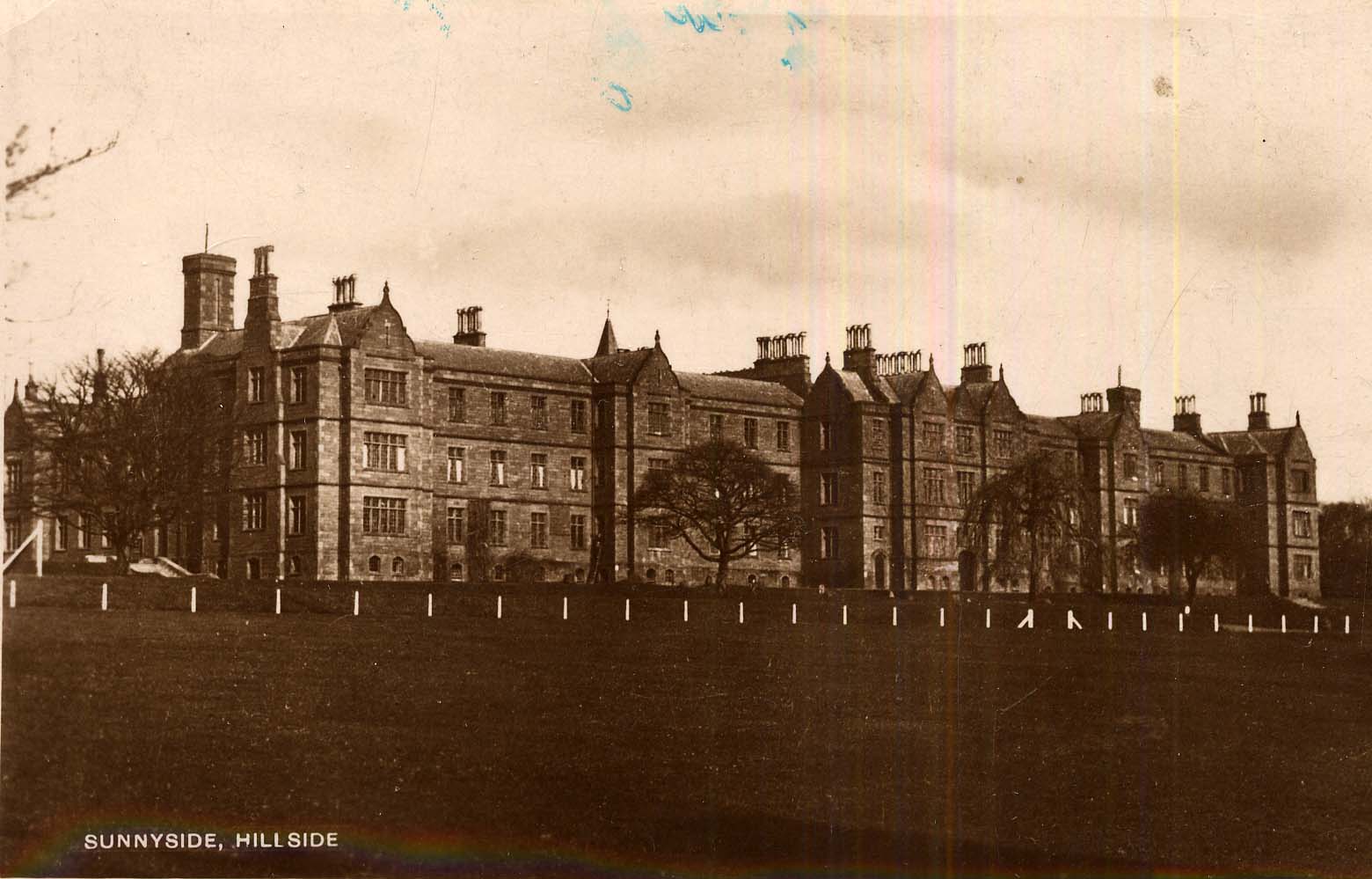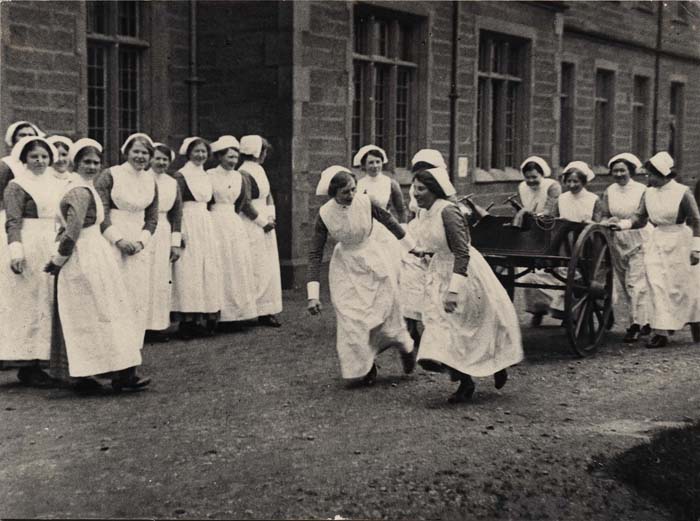
| Sunnyside Lunatic Asylum |
 |
|
The Montrose Lunatic Asylum, Infirmary and Dispensary was founded in 1781 by Mrs. Susan Carnegie of Charleton for the treatment of private and pauper patients. In later years, Mrs. Carnegie described her purpose in creating the asylum: My view was… To rid the Town of Montrose of a nuisance, that of mad people being kept in prison in the middle of the street, and the hope that by providing a quiet and convenient Asylum for them, by good treatment and medical aid, some of those unfortunates might be restored to society. The Montrose Lunatic Asylum was originally granted a Royal Charter in 1810. The Montrose Asylum was the first mental hospital in Scotland. Prior to this, insane patients were treated in the Old Tollbooth in Montrose High Street. The first lunatic patient was admitted on 6th May, 1782. Medical services were at first provided on a monthly rotation, for no extra payment, by the local doctors in addition to their other duties. Problems with this system led to Mrs. Carnegie, in 1799, recommending that the managers give consideration to payment for an attending physician or surgeon for a year at a time. Montrose Asylum was the birthplace of the modern asylum movement in Britain. (The word asylum literally means a place of safety .) The wellspring of the movement was a humanitarian concern to provide better living conditions for the ill, rather than medical ideas on treatment which evolved later. The asylum attracted inmates from up and down the East Coast. A new improved Asylum with better facilities was completed in 1858, (picture above) situated in lands of the farm of Sunnyside, in the village of Hillside, on the outskirts of Montrose. It still operates today as a hospital for the mentally ill. Recreation rooms in the main building, a magnificent Victorian structure, are sometimes used for local functions. (Below left: nurses and patients in a ward; below right: nurses participating in a fire drill.) |
|
 |
 |
|
The British government conducted a study of lunatic asylums in Scotland in 1855. From that report, we learn that insane people were typically entrusted to their relatives for their care but there were also public as well as private madhouses within the country. By law, any house containing more than 100 residents was required to have a resident physician or surgeon; if there were less, then it had to be visited twice a week by a surgeon who once a week had to enter a report in the register. Asylums and madhouses also had to keep a record of when patients were taken in, any restraint that was necessary and if they were cured or died in the institution. The conditions in which lunatics were kept was found to be bad in many cases, often with two patients to a bed. The various classes of lunatic asylums in Scotland fell into two categories: chartered asylums, founded by donations and legacies, and district asylums, which were supported by assessment and catered, on the whole, for paupers. Sunnyside was a district asylum.
In an 1859 report, Dr. James Coxe, a medical commissioner of the Board of Lunacy in Scotland, gave Scottish evidence as follows: On 1st January, 1858, there were 5,748 lunatics in Scotland plus nearly 1,800 in private houses. The majority were in public or chartered asylums, others in licensed houses and in the lunatic wards of the poor houses. The asylums at Dumfries and Perth were founded by bequests, the rest by subscriptions. The licensed houses were private speculations opened by licence from the Lunacy Board who had the right of inspection. Poor house lunatic wards had, in the main, been started as a consequence of overcrowding of the public asylums and were usually part of the poor house, but sometimes could be in a separate building. These wards were supported entirely by the parish. The following excerpts from the Lunacy Scotland (1869) report give us a sense of the care that Elizabeth was receiving in 1869, approximately two years after she had been admitted. The Montrose Asylum was as usual found in excellent order. The treatment of the patients continues to be conducted without recourse to seclusion, and without undue restriction to the airing-courts. The employment and recreation of the patients continue to be objects of careful and persistent study. The number of patients on the books of the asylum at this date is 390 or 169 males and 221 females. This number is considerably in excess of the amount of accommodation as originally estimated. It is to be observed, however, that further expedients and adaptations of the existing accommodation have been carried out since our last visit, or are in contemplation, with a view to meet the increasing demands for admission, so that there is little if any appearance of overcrowding. But notwithstanding all that has been done or is doing to meet them, the demands for admission, especially by female paupers, continue to be such as to make it a matter of constant solicitude how to make the most of the available space, which the Asylum can afford. Since the date of our last report, 16 male and 36 female patients have been admitted. Of the paupers, 8 are chargeable to Dundee....... The health and condition of the patients at the time of admission is reported as good in 24 cases, feeble in 12, indifferent in 8, and bad in 8. Two were transfers from other asylums, the rest were admitted on Sheriffs' orders. There have been 13 deaths. Of these, 7 were from paralysis or other cerebral diseases... The good order, general appearance of comfort, cleanliness, and presiding quiet and tranquility among the patients throughout all the wards and galleries were extremely noteworthy. On this occasion, 117 patients dined in association in the basement corridor. The meal was well served, consisting of broth, potatoes, and hash, and was partaken of with perfect quietness and order. A certain number of the more infirm and excitable patients, amounting to 34 males and 51 females, were found in like manner dining in association in the sick wards. The occupations and amusements of the patients continue to receive commendable attention. The latter consist of balls, concerts, singing and other classes, readings, and outdoor games, besides occasional theatricals and other special entertainments. On the male side 101 and on the female 121 patients are industrially employed. All patients, if not prevented by physical infirmities, take exercise in the general grounds, either under the eye of an attendant or on parole, while 33 are allowed to pass beyond the bounds of the Asylum. The number attending chapel or prayers is 238. Both sexes were comfortably clothed, and were clean in person and dress. The bedding was sufficient and in good order. Considering the large proportion of patients whose physical constitution is utterly broken down, this result cannot be regarded as anything but satisfactory. The numbers employed are 143 males and 135 females. Of the former, 78 are occupied in the work of the farm; but there is still room for extension in the employment of both sexes on the land, and no opportunity should be lost in adding to it. Of the females, 67 are engaged in sewing, knitting, and darning, 12 in mattress-making, and 56 in the work of the laundry, kitchen, and house. If the way could be seen to allow the patients some pecuniary consideration for their labour, not necessarily for mere personal expenditure, but to defray the cost of excursions, entertainments, articles of ornamental furniture, etc., the result, judging from the success of similar experiments elsewhere would be to excite to greater industry, and to infuse a spirit of emulation in the decoration and neatness of the different galleries. Sources Royal Asylum of Montrose (http://134.36.1.31/dserve/dserve2/exhibition/sunnysideexhibition.html) Lunatic Asylums (Scotland). Report of Her Majesty's Commissioners. Appendix and index, 1857. Scotland in the 19th century (http://gdl.cdlr.strath.ac.uk/haynin/haynin0812.htm) Care and Treatment of Lunatics. Report of the Select Committee. Minutes of evidence, appendix and index, 1859. Scotland in the 19th century (http://gdl.cdlr.strath.ac.uk/haynin/haynin0812.htm) Lunacy (Scotland). Reports from Commissioners, Volume 34, 1870.(http://books.google.com/books) Search term = "district asylums" "montrose." |
|